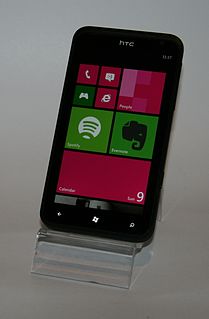Microsoft Windows, commonly referred to as Windows, is a group of several proprietary graphical operating system families, all of which are developed and marketed by Microsoft. Each family caters to a certain sector of the computing industry. Active Microsoft Windows families include Windows NT and Windows IoT; these may encompass subfamilies,. Defunct Microsoft Windows families include Windows 9x, Windows Mobile, and Windows Phone.

Safari is a graphical web browser developed by Apple, based on the WebKit engine. First released on desktop in 2003 with Mac OS X Panther, a mobile version has been bundled with iOS devices since the iPhone's introduction in 2007. Safari is the default browser on Apple devices. A Windows version was available from 2007 to 2012.
Operating systems OS 10 or operating system 10 or variation, may refer to:

Microsoft Silverlight is a deprecated application framework designed for writing and running rich web applications, similar to Adobe's own runtime, Adobe Flash. A plugin for Silverlight is still available for a very small number of browsers. While early versions of Silverlight focused on streaming media, later versions supported multimedia, graphics, and animation, and gave support to developers for CLI languages and development tools. Silverlight was also one of the two application development platforms for Windows Phone, but web pages using Silverlight did not run on the Windows Phone or Windows Mobile versions of Internet Explorer, as there was no Silverlight plugin for Internet Explorer on those platforms.
A mobile operating system is an operating system for mobile phones, tablets, smartwatches, 2-in-1 PCs, smart speakers, or other mobile devices. While computers such as typical laptops are 'mobile', the operating systems used on them are generally not considered mobile ones, as they were originally designed for desktop computers that historically did not have or need specific mobile features. This distinction is becoming blurred in some newer operating systems that are hybrids made for both uses.

Windows Phone (WP) is a discontinued family of mobile operating systems developed by Microsoft for smartphones as the replacement successor to Windows Mobile and Zune. Windows Phone featured a new user interface derived from the Metro design language. Unlike Windows Mobile, it was primarily aimed at the consumer market rather than the enterprise market.

MSN Messenger, later rebranded as Windows Live Messenger, was a cross-platform instant messaging client developed by Microsoft. It connected to the Microsoft Messenger service while also having compatibility with Yahoo! Messenger and Facebook Messenger. The client was first released as MSN Messenger Service on July 22, 1999, and was marketed under the MSN branding until 2005 when it was rebranded under Windows Live. It has since been officially known by its second name, although its first name was still used colloquially by most of its users. In June 2009, Microsoft reported the service attracted over 330 million active users each month, placing Messenger among the most widely used instant messaging clients in the world.

Windows Marketplace for Mobile was a service by Microsoft for its Windows Mobile platform that allowed users to browse and download applications that had been developed by third parties. The service was available for use directly on Windows Mobile 6.x devices and on personal computers. It was announced at the 2009 Mobile World Congress, and began operation on 6 October 2009, featuring an initial 246 applications. Initially it was available only for Windows Mobile 6.5, and was made available to older 6.x versions a few weeks later. On February 15, 2010 Microsoft announced its next generation mobile platform named Windows Phone; there is a separate app store, Windows Phone Store, for it; WM6.x apps are not compatible with WP7.

MixRadio was an online music streaming service owned by Line Corporation. The service was first introduced by Nokia in 2011 as Nokia Music for Windows Phone, serving as a successor to Nokia's previous Nokia Music Store/Comes with Music/Ovi Music Store initiatives, which was based on the LoudEye/OD2 platform. After its acquisition of Nokia's mobile phone business, the service was briefly maintained by Microsoft Mobile Oy before it was sold to Japanese internet company Line Corporation in 2015. Following the acquisition, MixRadio expanded to Android and iOS in May 2015.
This page provides details for the version history of the Microsoft's Windows Phone branded mobile operating systems, from the release of Windows Phone 7 in October 2010, which was preceded by Windows Mobile version 6.x.

{{|date=July 2020}}

The Windows Phone 8X by HTC is a smartphone that was announced by HTC Corporation on September 19, 2012.

Windows Phone 7 is the first release of the Windows Phone mobile client operating system, released worldwide on October 21, 2010, and in the United States on November 8, 2010. It runs on the Windows CE 6.0 kernel.

Universal Windows Platform (UWP) apps are applications that can be used across all compatible Microsoft Windows devices, including personal computers (PCs), tablets, smartphones, Xbox One, Microsoft HoloLens, and Internet of Things. UWP software is primarily purchased and downloaded via the Microsoft Store.
Windows 8.x refers to the following versions of Microsoft Windows operating systems:

The Nokia X family was a range of budget smartphones that was produced and marketed by Microsoft Mobile, originally introduced in February 2014 by Nokia. The smartphones run on the Nokia X platform, a Linux-based operating system which was a fork of Android. Nokia X is also known generally as the Nokia Normandy. It is regarded as Nokia's first Android device during the company's Microsoft partnership and was in the process of selling its mobile phone business to Microsoft, which eventually happened two months later.

Action Center is a notification center included with Windows Phone 8.1, Windows 10 and Windows 10 Mobile. It was first introduced with Windows Phone 8.1 in July 2014, and was introduced to the desktop with the launch of Windows 10 on July 29, 2015.








